QUTIC Report: Student Awareness of Plagiarism and Solutions
VerifiedAdded on 2020/03/28
|12
|1456
|49
Report
AI Summary
This report, prepared for QUTIC management, investigates student perceptions of plagiarism to promote academic integrity and prevent dishonesty. The research, conducted via questionnaires distributed to students from diverse faculties and nationalities, explores students' awareness of plagiarism, their reasons for plagiarizing, and their understanding of the consequences. Findings reveal varying levels of understanding of plagiarism, diverse motivations for engaging in it (including time management, language barriers, and unclear rules), and a general awareness of its serious consequences. Based on these findings, the report recommends that QUTIC provide more education on plagiarism, offer LLA workshops, develop user-friendly plagiarism-checking applications, and implement stricter punishments for academic dishonesty. The report also emphasizes the importance of clarifying plagiarism rules and helping students understand the ethical implications of plagiarism within the Australian academic context. The study includes appendices with marked and unmarked questionnaires, as well as a tally sheet of responses.
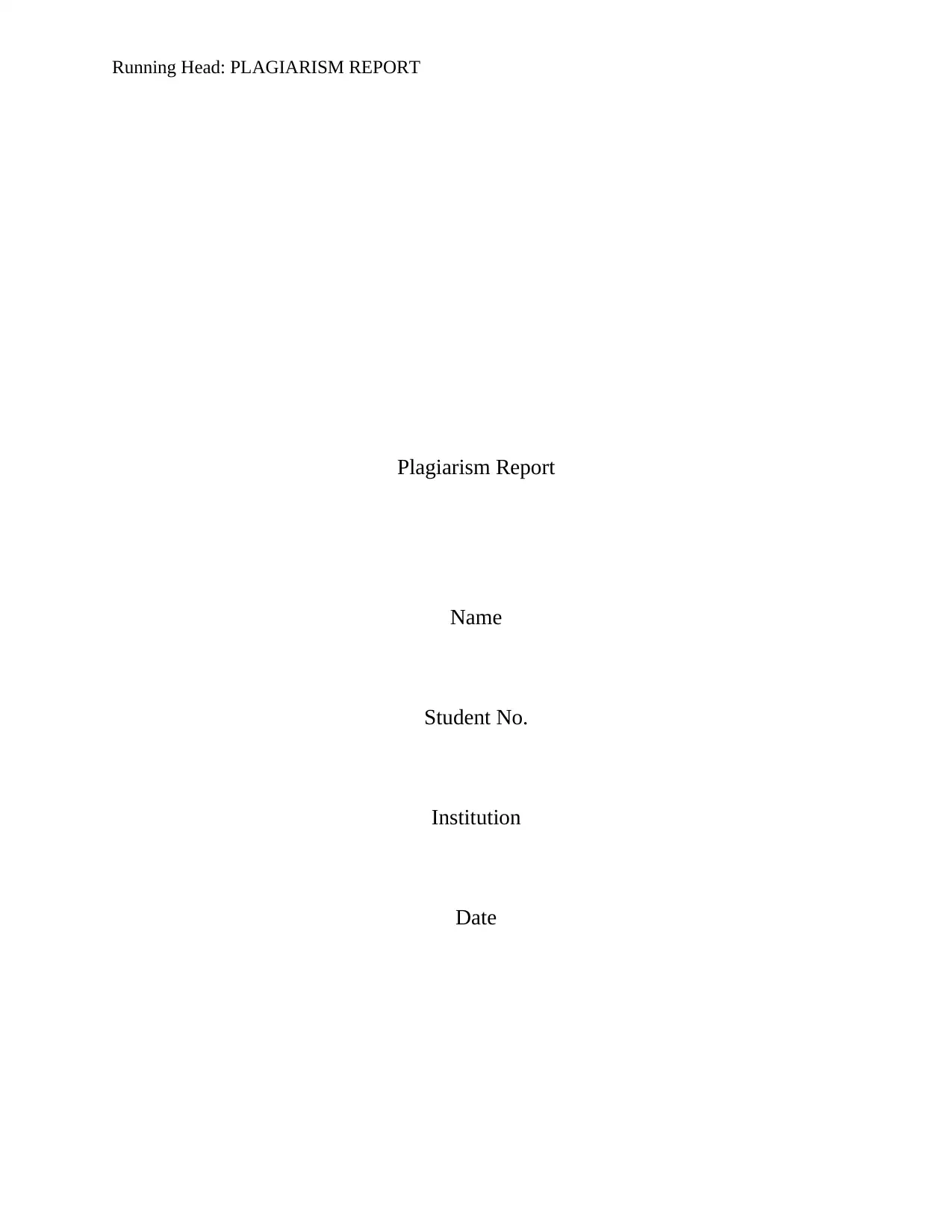
Running Head: PLAGIARISM REPORT
Plagiarism Report
Name
Student No.
Institution
Date
Plagiarism Report
Name
Student No.
Institution
Date
Paraphrase This Document
Need a fresh take? Get an instant paraphrase of this document with our AI Paraphraser
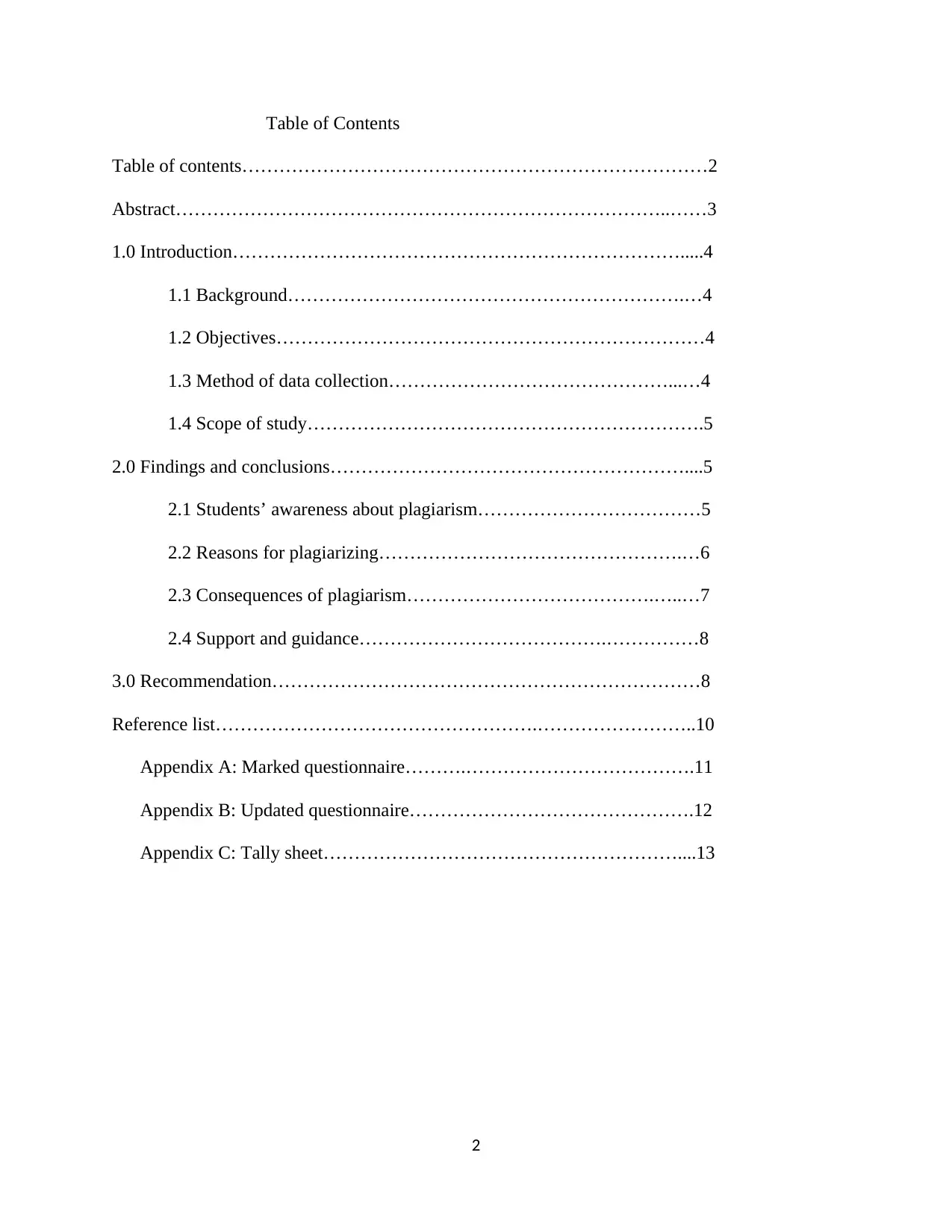
Table of Contents
Table of contents…………………………………………………………………2
Abstract……………………………………………………………………..……3
1.0 Introduction……………………………………………………………….....4
1.1 Background……………………………………………………….…4
1.2 Objectives……………………………………………………………4
1.3 Method of data collection………………………………………...…4
1.4 Scope of study……………………………………………………….5
2.0 Findings and conclusions…………………………………………………....5
2.1 Students’ awareness about plagiarism………………………………5
2.2 Reasons for plagiarizing………………………………………….…6
2.3 Consequences of plagiarism………………………………….…..…7
2.4 Support and guidance………………………………….……………8
3.0 Recommendation……………………………………………………………8
Reference list…………………………………………….……………………..10
Appendix A: Marked questionnaire……….……………………………….11
Appendix B: Updated questionnaire……………………………………….12
Appendix C: Tally sheet…………………………………………………....13
2
Table of contents…………………………………………………………………2
Abstract……………………………………………………………………..……3
1.0 Introduction……………………………………………………………….....4
1.1 Background……………………………………………………….…4
1.2 Objectives……………………………………………………………4
1.3 Method of data collection………………………………………...…4
1.4 Scope of study……………………………………………………….5
2.0 Findings and conclusions…………………………………………………....5
2.1 Students’ awareness about plagiarism………………………………5
2.2 Reasons for plagiarizing………………………………………….…6
2.3 Consequences of plagiarism………………………………….…..…7
2.4 Support and guidance………………………………….……………8
3.0 Recommendation……………………………………………………………8
Reference list…………………………………………….……………………..10
Appendix A: Marked questionnaire……….……………………………….11
Appendix B: Updated questionnaire……………………………………….12
Appendix C: Tally sheet…………………………………………………....13
2
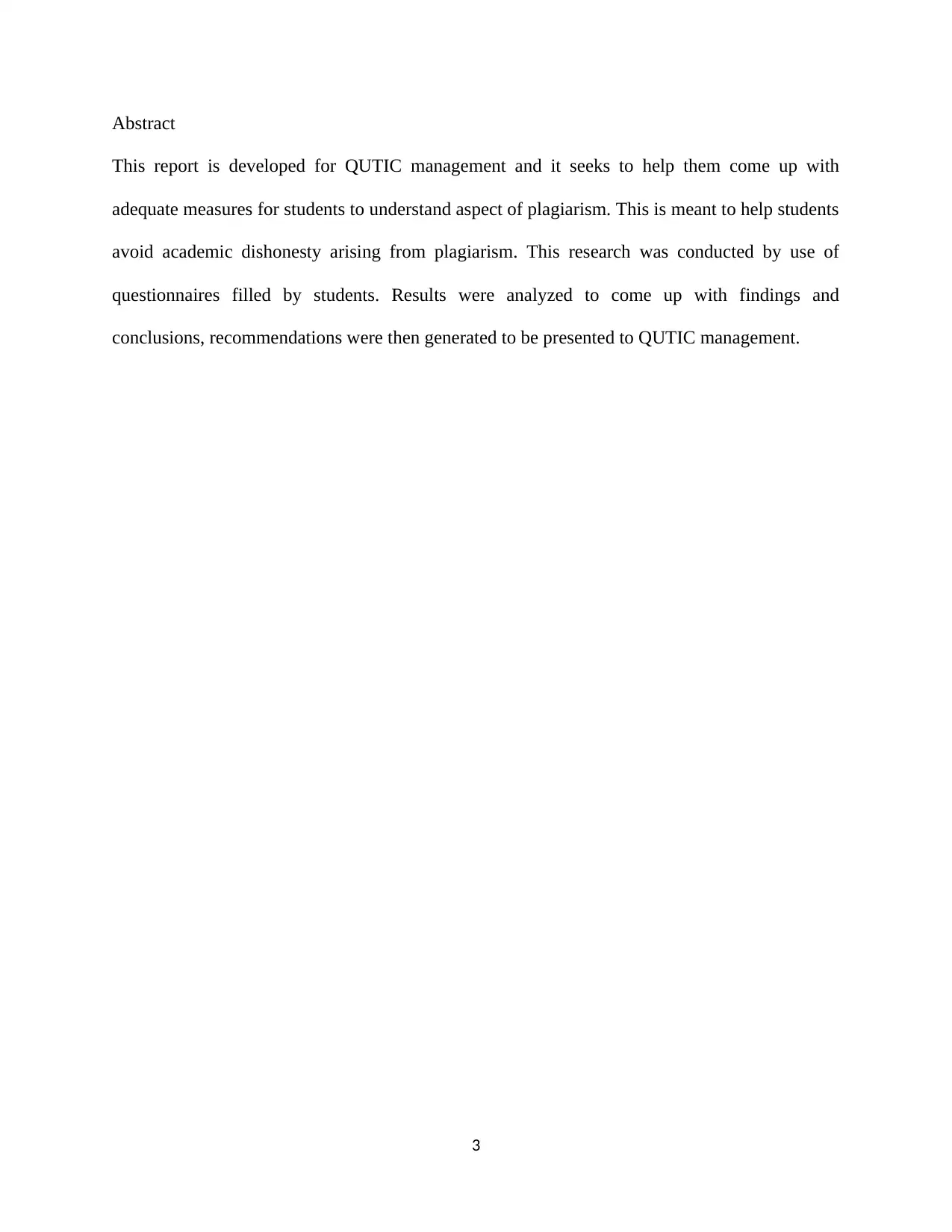
Abstract
This report is developed for QUTIC management and it seeks to help them come up with
adequate measures for students to understand aspect of plagiarism. This is meant to help students
avoid academic dishonesty arising from plagiarism. This research was conducted by use of
questionnaires filled by students. Results were analyzed to come up with findings and
conclusions, recommendations were then generated to be presented to QUTIC management.
3
This report is developed for QUTIC management and it seeks to help them come up with
adequate measures for students to understand aspect of plagiarism. This is meant to help students
avoid academic dishonesty arising from plagiarism. This research was conducted by use of
questionnaires filled by students. Results were analyzed to come up with findings and
conclusions, recommendations were then generated to be presented to QUTIC management.
3
⊘ This is a preview!⊘
Do you want full access?
Subscribe today to unlock all pages.

Trusted by 1+ million students worldwide
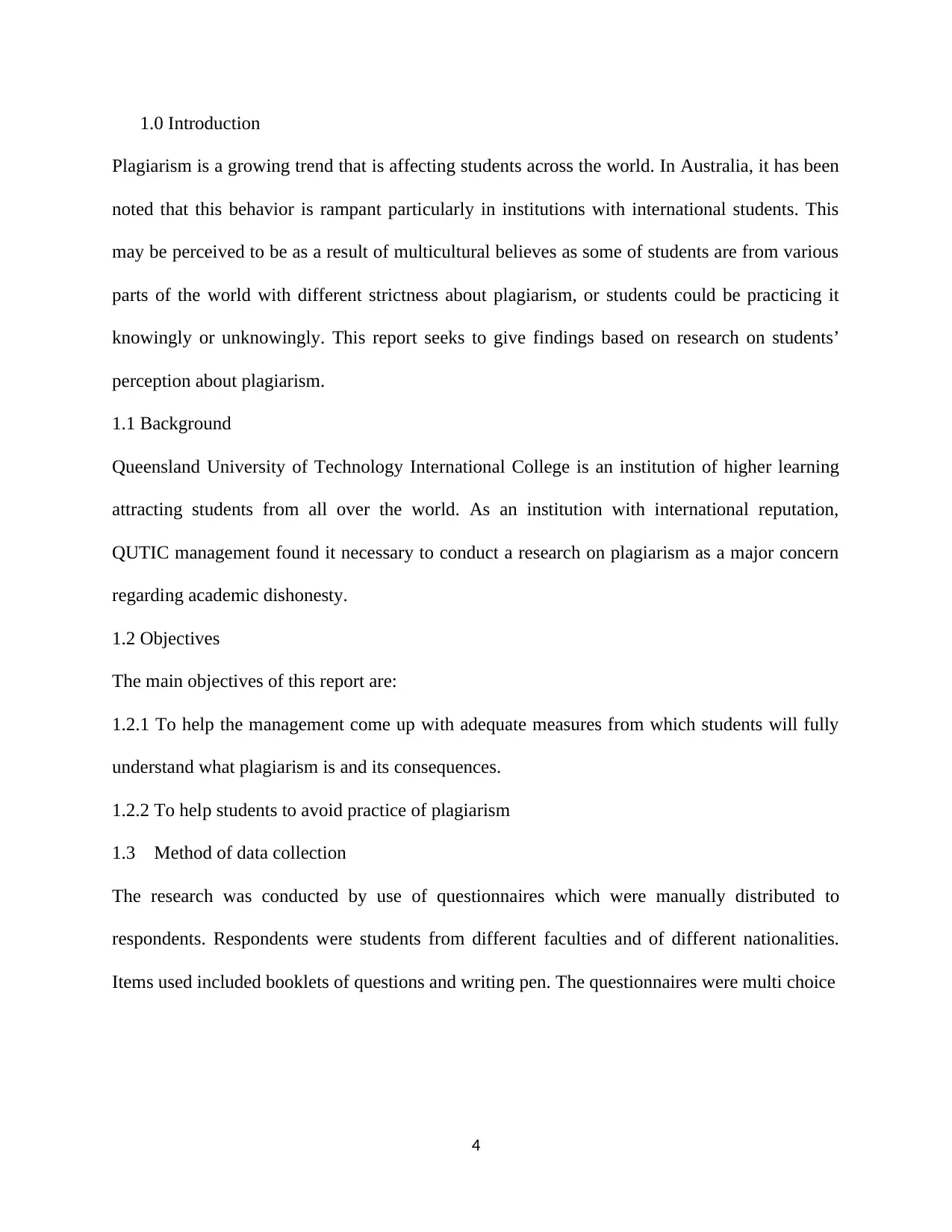
1.0 Introduction
Plagiarism is a growing trend that is affecting students across the world. In Australia, it has been
noted that this behavior is rampant particularly in institutions with international students. This
may be perceived to be as a result of multicultural believes as some of students are from various
parts of the world with different strictness about plagiarism, or students could be practicing it
knowingly or unknowingly. This report seeks to give findings based on research on students’
perception about plagiarism.
1.1 Background
Queensland University of Technology International College is an institution of higher learning
attracting students from all over the world. As an institution with international reputation,
QUTIC management found it necessary to conduct a research on plagiarism as a major concern
regarding academic dishonesty.
1.2 Objectives
The main objectives of this report are:
1.2.1 To help the management come up with adequate measures from which students will fully
understand what plagiarism is and its consequences.
1.2.2 To help students to avoid practice of plagiarism
1.3 Method of data collection
The research was conducted by use of questionnaires which were manually distributed to
respondents. Respondents were students from different faculties and of different nationalities.
Items used included booklets of questions and writing pen. The questionnaires were multi choice
4
Plagiarism is a growing trend that is affecting students across the world. In Australia, it has been
noted that this behavior is rampant particularly in institutions with international students. This
may be perceived to be as a result of multicultural believes as some of students are from various
parts of the world with different strictness about plagiarism, or students could be practicing it
knowingly or unknowingly. This report seeks to give findings based on research on students’
perception about plagiarism.
1.1 Background
Queensland University of Technology International College is an institution of higher learning
attracting students from all over the world. As an institution with international reputation,
QUTIC management found it necessary to conduct a research on plagiarism as a major concern
regarding academic dishonesty.
1.2 Objectives
The main objectives of this report are:
1.2.1 To help the management come up with adequate measures from which students will fully
understand what plagiarism is and its consequences.
1.2.2 To help students to avoid practice of plagiarism
1.3 Method of data collection
The research was conducted by use of questionnaires which were manually distributed to
respondents. Respondents were students from different faculties and of different nationalities.
Items used included booklets of questions and writing pen. The questionnaires were multi choice
4
Paraphrase This Document
Need a fresh take? Get an instant paraphrase of this document with our AI Paraphraser
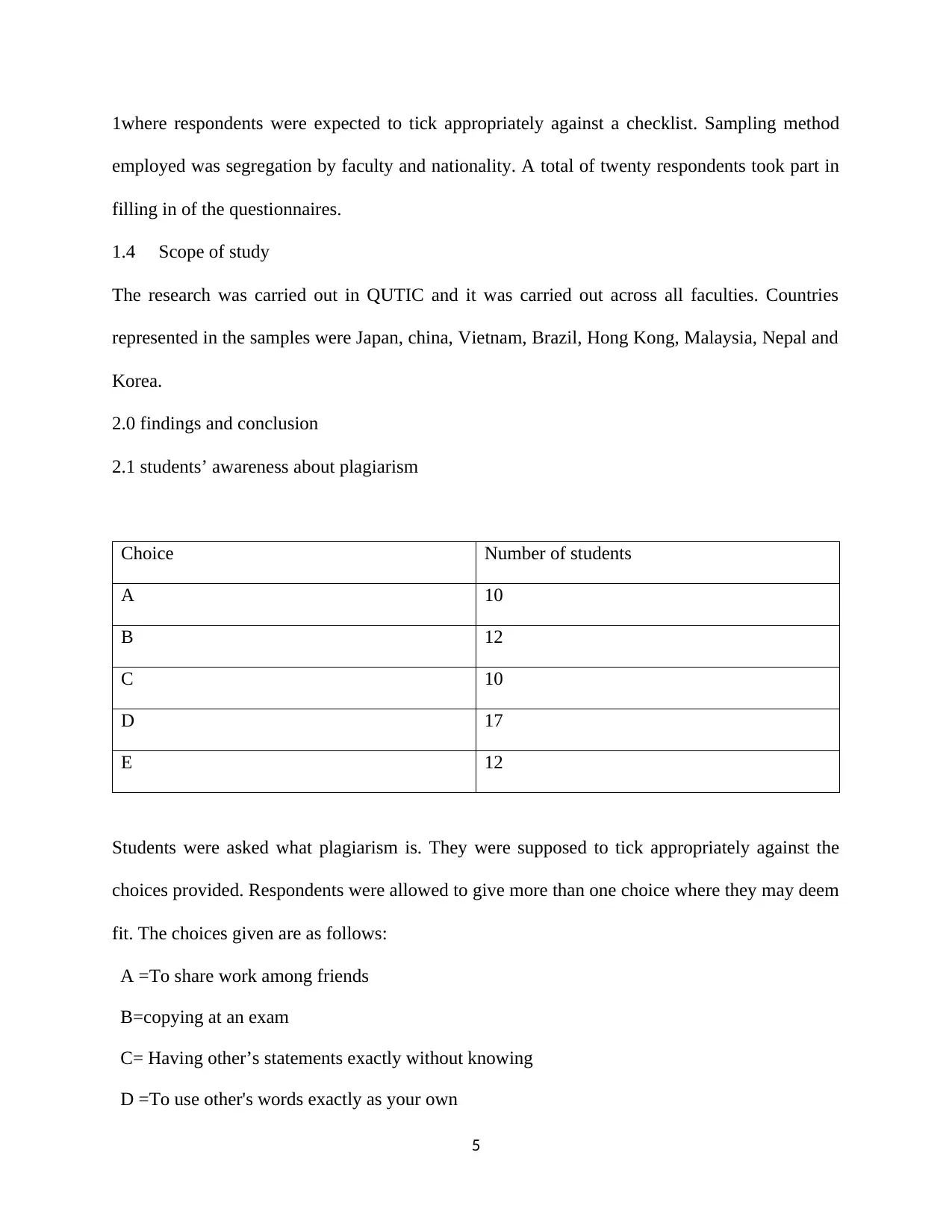
1where respondents were expected to tick appropriately against a checklist. Sampling method
employed was segregation by faculty and nationality. A total of twenty respondents took part in
filling in of the questionnaires.
1.4 Scope of study
The research was carried out in QUTIC and it was carried out across all faculties. Countries
represented in the samples were Japan, china, Vietnam, Brazil, Hong Kong, Malaysia, Nepal and
Korea.
2.0 findings and conclusion
2.1 students’ awareness about plagiarism
Choice Number of students
A 10
B 12
C 10
D 17
E 12
Students were asked what plagiarism is. They were supposed to tick appropriately against the
choices provided. Respondents were allowed to give more than one choice where they may deem
fit. The choices given are as follows:
A =To share work among friends
B=copying at an exam
C= Having other’s statements exactly without knowing
D =To use other's words exactly as your own
5
employed was segregation by faculty and nationality. A total of twenty respondents took part in
filling in of the questionnaires.
1.4 Scope of study
The research was carried out in QUTIC and it was carried out across all faculties. Countries
represented in the samples were Japan, china, Vietnam, Brazil, Hong Kong, Malaysia, Nepal and
Korea.
2.0 findings and conclusion
2.1 students’ awareness about plagiarism
Choice Number of students
A 10
B 12
C 10
D 17
E 12
Students were asked what plagiarism is. They were supposed to tick appropriately against the
choices provided. Respondents were allowed to give more than one choice where they may deem
fit. The choices given are as follows:
A =To share work among friends
B=copying at an exam
C= Having other’s statements exactly without knowing
D =To use other's words exactly as your own
5
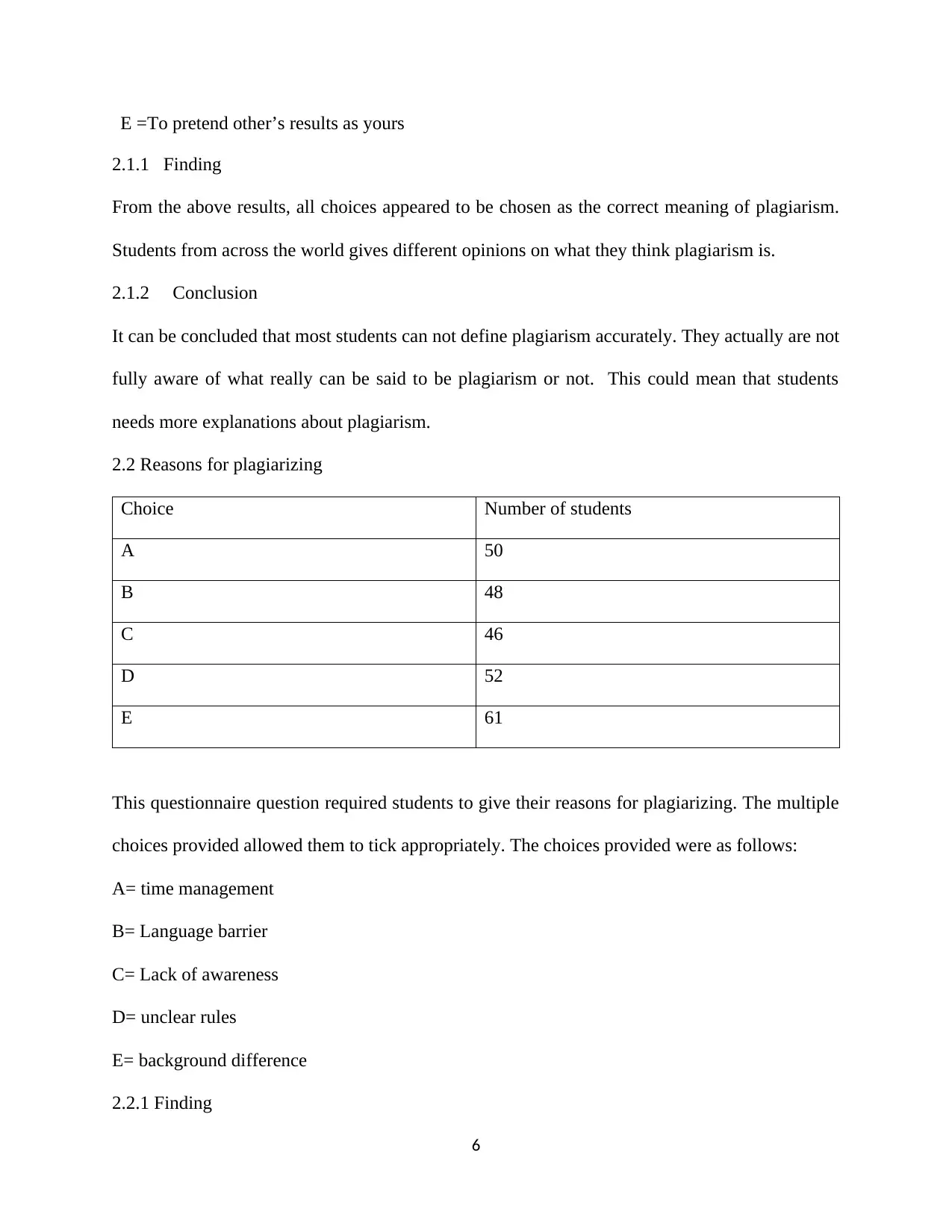
E =To pretend other’s results as yours
2.1.1 Finding
From the above results, all choices appeared to be chosen as the correct meaning of plagiarism.
Students from across the world gives different opinions on what they think plagiarism is.
2.1.2 Conclusion
It can be concluded that most students can not define plagiarism accurately. They actually are not
fully aware of what really can be said to be plagiarism or not. This could mean that students
needs more explanations about plagiarism.
2.2 Reasons for plagiarizing
Choice Number of students
A 50
B 48
C 46
D 52
E 61
This questionnaire question required students to give their reasons for plagiarizing. The multiple
choices provided allowed them to tick appropriately. The choices provided were as follows:
A= time management
B= Language barrier
C= Lack of awareness
D= unclear rules
E= background difference
2.2.1 Finding
6
2.1.1 Finding
From the above results, all choices appeared to be chosen as the correct meaning of plagiarism.
Students from across the world gives different opinions on what they think plagiarism is.
2.1.2 Conclusion
It can be concluded that most students can not define plagiarism accurately. They actually are not
fully aware of what really can be said to be plagiarism or not. This could mean that students
needs more explanations about plagiarism.
2.2 Reasons for plagiarizing
Choice Number of students
A 50
B 48
C 46
D 52
E 61
This questionnaire question required students to give their reasons for plagiarizing. The multiple
choices provided allowed them to tick appropriately. The choices provided were as follows:
A= time management
B= Language barrier
C= Lack of awareness
D= unclear rules
E= background difference
2.2.1 Finding
6
⊘ This is a preview!⊘
Do you want full access?
Subscribe today to unlock all pages.

Trusted by 1+ million students worldwide
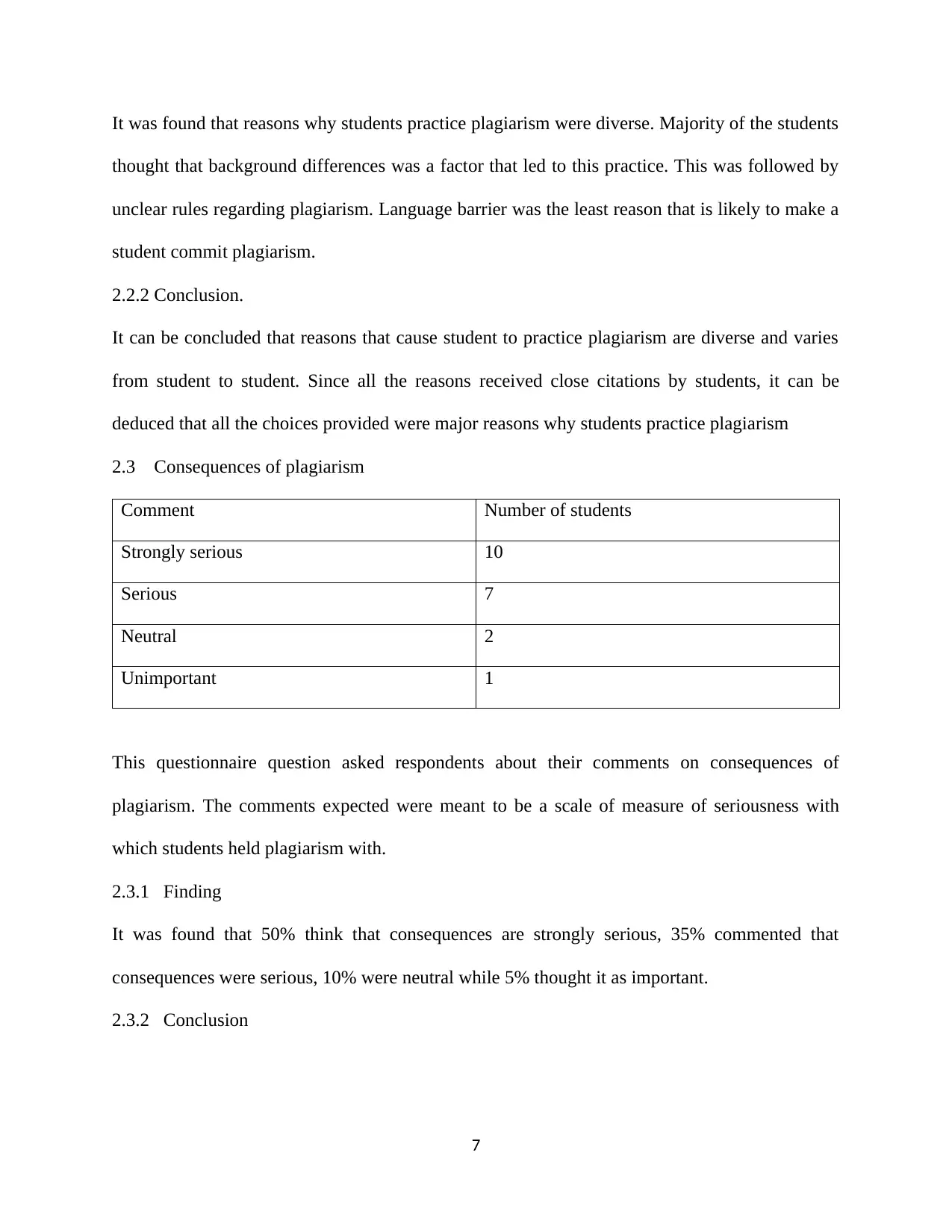
It was found that reasons why students practice plagiarism were diverse. Majority of the students
thought that background differences was a factor that led to this practice. This was followed by
unclear rules regarding plagiarism. Language barrier was the least reason that is likely to make a
student commit plagiarism.
2.2.2 Conclusion.
It can be concluded that reasons that cause student to practice plagiarism are diverse and varies
from student to student. Since all the reasons received close citations by students, it can be
deduced that all the choices provided were major reasons why students practice plagiarism
2.3 Consequences of plagiarism
Comment Number of students
Strongly serious 10
Serious 7
Neutral 2
Unimportant 1
This questionnaire question asked respondents about their comments on consequences of
plagiarism. The comments expected were meant to be a scale of measure of seriousness with
which students held plagiarism with.
2.3.1 Finding
It was found that 50% think that consequences are strongly serious, 35% commented that
consequences were serious, 10% were neutral while 5% thought it as important.
2.3.2 Conclusion
7
thought that background differences was a factor that led to this practice. This was followed by
unclear rules regarding plagiarism. Language barrier was the least reason that is likely to make a
student commit plagiarism.
2.2.2 Conclusion.
It can be concluded that reasons that cause student to practice plagiarism are diverse and varies
from student to student. Since all the reasons received close citations by students, it can be
deduced that all the choices provided were major reasons why students practice plagiarism
2.3 Consequences of plagiarism
Comment Number of students
Strongly serious 10
Serious 7
Neutral 2
Unimportant 1
This questionnaire question asked respondents about their comments on consequences of
plagiarism. The comments expected were meant to be a scale of measure of seriousness with
which students held plagiarism with.
2.3.1 Finding
It was found that 50% think that consequences are strongly serious, 35% commented that
consequences were serious, 10% were neutral while 5% thought it as important.
2.3.2 Conclusion
7
Paraphrase This Document
Need a fresh take? Get an instant paraphrase of this document with our AI Paraphraser
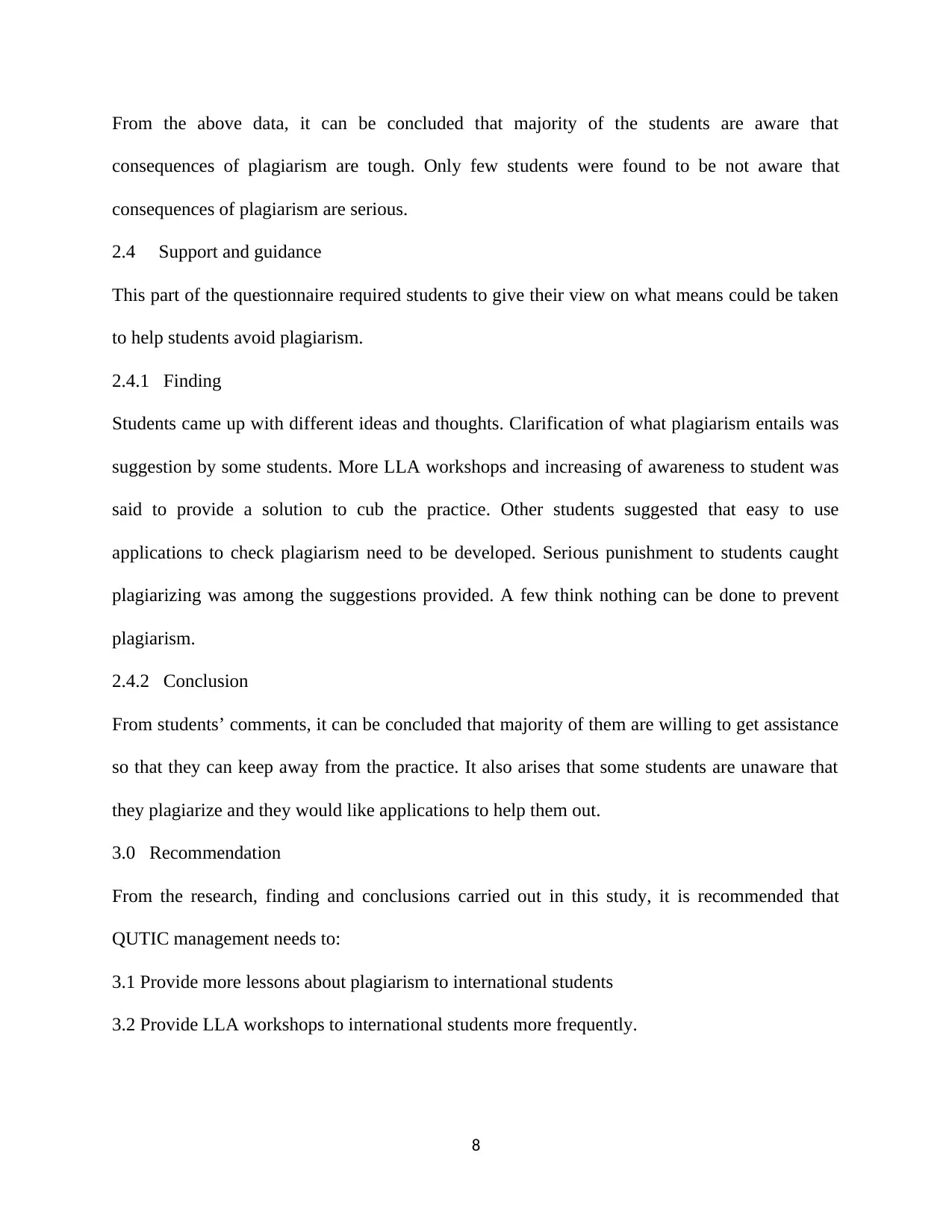
From the above data, it can be concluded that majority of the students are aware that
consequences of plagiarism are tough. Only few students were found to be not aware that
consequences of plagiarism are serious.
2.4 Support and guidance
This part of the questionnaire required students to give their view on what means could be taken
to help students avoid plagiarism.
2.4.1 Finding
Students came up with different ideas and thoughts. Clarification of what plagiarism entails was
suggestion by some students. More LLA workshops and increasing of awareness to student was
said to provide a solution to cub the practice. Other students suggested that easy to use
applications to check plagiarism need to be developed. Serious punishment to students caught
plagiarizing was among the suggestions provided. A few think nothing can be done to prevent
plagiarism.
2.4.2 Conclusion
From students’ comments, it can be concluded that majority of them are willing to get assistance
so that they can keep away from the practice. It also arises that some students are unaware that
they plagiarize and they would like applications to help them out.
3.0 Recommendation
From the research, finding and conclusions carried out in this study, it is recommended that
QUTIC management needs to:
3.1 Provide more lessons about plagiarism to international students
3.2 Provide LLA workshops to international students more frequently.
8
consequences of plagiarism are tough. Only few students were found to be not aware that
consequences of plagiarism are serious.
2.4 Support and guidance
This part of the questionnaire required students to give their view on what means could be taken
to help students avoid plagiarism.
2.4.1 Finding
Students came up with different ideas and thoughts. Clarification of what plagiarism entails was
suggestion by some students. More LLA workshops and increasing of awareness to student was
said to provide a solution to cub the practice. Other students suggested that easy to use
applications to check plagiarism need to be developed. Serious punishment to students caught
plagiarizing was among the suggestions provided. A few think nothing can be done to prevent
plagiarism.
2.4.2 Conclusion
From students’ comments, it can be concluded that majority of them are willing to get assistance
so that they can keep away from the practice. It also arises that some students are unaware that
they plagiarize and they would like applications to help them out.
3.0 Recommendation
From the research, finding and conclusions carried out in this study, it is recommended that
QUTIC management needs to:
3.1 Provide more lessons about plagiarism to international students
3.2 Provide LLA workshops to international students more frequently.
8
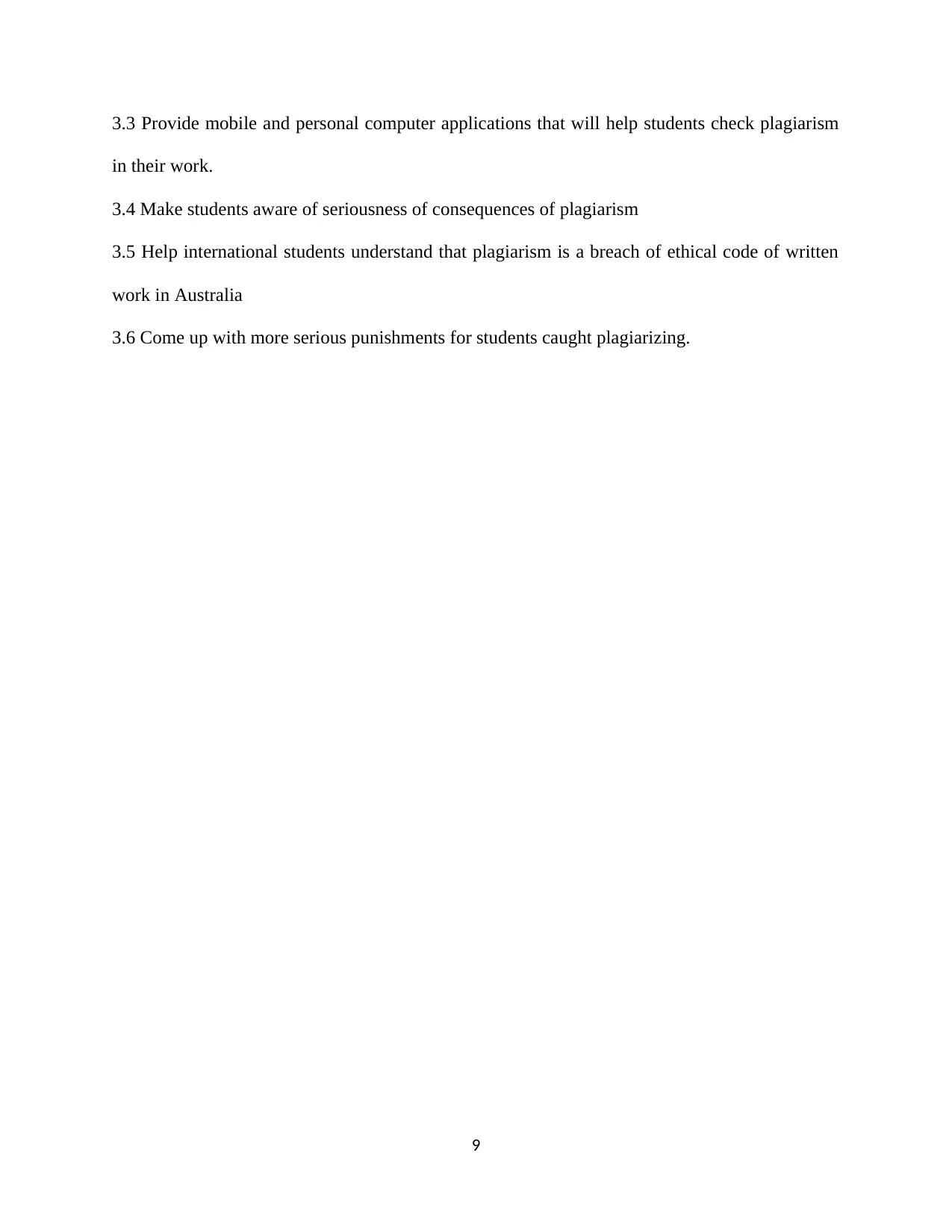
3.3 Provide mobile and personal computer applications that will help students check plagiarism
in their work.
3.4 Make students aware of seriousness of consequences of plagiarism
3.5 Help international students understand that plagiarism is a breach of ethical code of written
work in Australia
3.6 Come up with more serious punishments for students caught plagiarizing.
9
in their work.
3.4 Make students aware of seriousness of consequences of plagiarism
3.5 Help international students understand that plagiarism is a breach of ethical code of written
work in Australia
3.6 Come up with more serious punishments for students caught plagiarizing.
9
⊘ This is a preview!⊘
Do you want full access?
Subscribe today to unlock all pages.

Trusted by 1+ million students worldwide
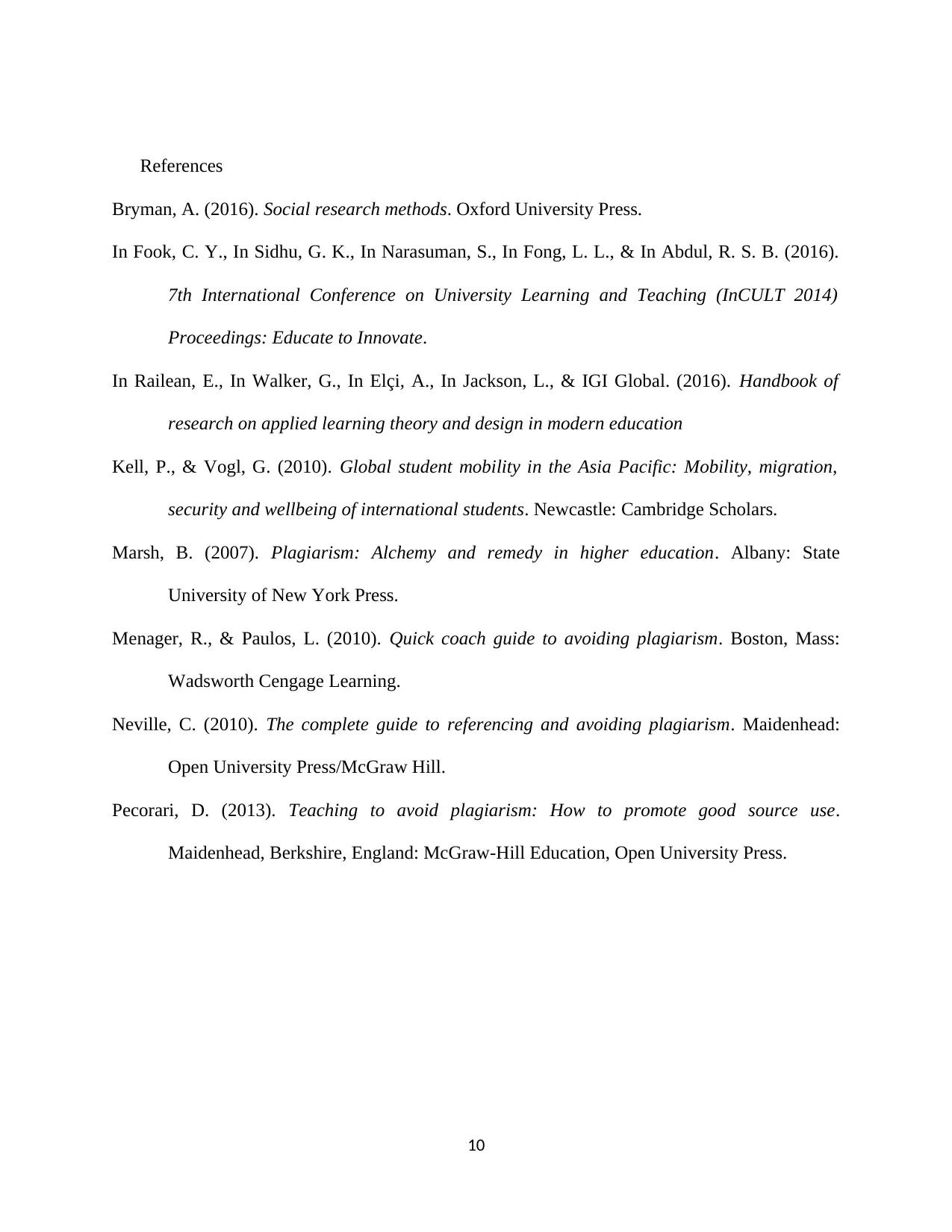
References
Bryman, A. (2016). Social research methods. Oxford University Press.
In Fook, C. Y., In Sidhu, G. K., In Narasuman, S., In Fong, L. L., & In Abdul, R. S. B. (2016).
7th International Conference on University Learning and Teaching (InCULT 2014)
Proceedings: Educate to Innovate.
In Railean, E., In Walker, G., In Elçi, A., In Jackson, L., & IGI Global. (2016). Handbook of
research on applied learning theory and design in modern education
Kell, P., & Vogl, G. (2010). Global student mobility in the Asia Pacific: Mobility, migration,
security and wellbeing of international students. Newcastle: Cambridge Scholars.
Marsh, B. (2007). Plagiarism: Alchemy and remedy in higher education. Albany: State
University of New York Press.
Menager, R., & Paulos, L. (2010). Quick coach guide to avoiding plagiarism. Boston, Mass:
Wadsworth Cengage Learning.
Neville, C. (2010). The complete guide to referencing and avoiding plagiarism. Maidenhead:
Open University Press/McGraw Hill.
Pecorari, D. (2013). Teaching to avoid plagiarism: How to promote good source use.
Maidenhead, Berkshire, England: McGraw-Hill Education, Open University Press.
10
Bryman, A. (2016). Social research methods. Oxford University Press.
In Fook, C. Y., In Sidhu, G. K., In Narasuman, S., In Fong, L. L., & In Abdul, R. S. B. (2016).
7th International Conference on University Learning and Teaching (InCULT 2014)
Proceedings: Educate to Innovate.
In Railean, E., In Walker, G., In Elçi, A., In Jackson, L., & IGI Global. (2016). Handbook of
research on applied learning theory and design in modern education
Kell, P., & Vogl, G. (2010). Global student mobility in the Asia Pacific: Mobility, migration,
security and wellbeing of international students. Newcastle: Cambridge Scholars.
Marsh, B. (2007). Plagiarism: Alchemy and remedy in higher education. Albany: State
University of New York Press.
Menager, R., & Paulos, L. (2010). Quick coach guide to avoiding plagiarism. Boston, Mass:
Wadsworth Cengage Learning.
Neville, C. (2010). The complete guide to referencing and avoiding plagiarism. Maidenhead:
Open University Press/McGraw Hill.
Pecorari, D. (2013). Teaching to avoid plagiarism: How to promote good source use.
Maidenhead, Berkshire, England: McGraw-Hill Education, Open University Press.
10
Paraphrase This Document
Need a fresh take? Get an instant paraphrase of this document with our AI Paraphraser
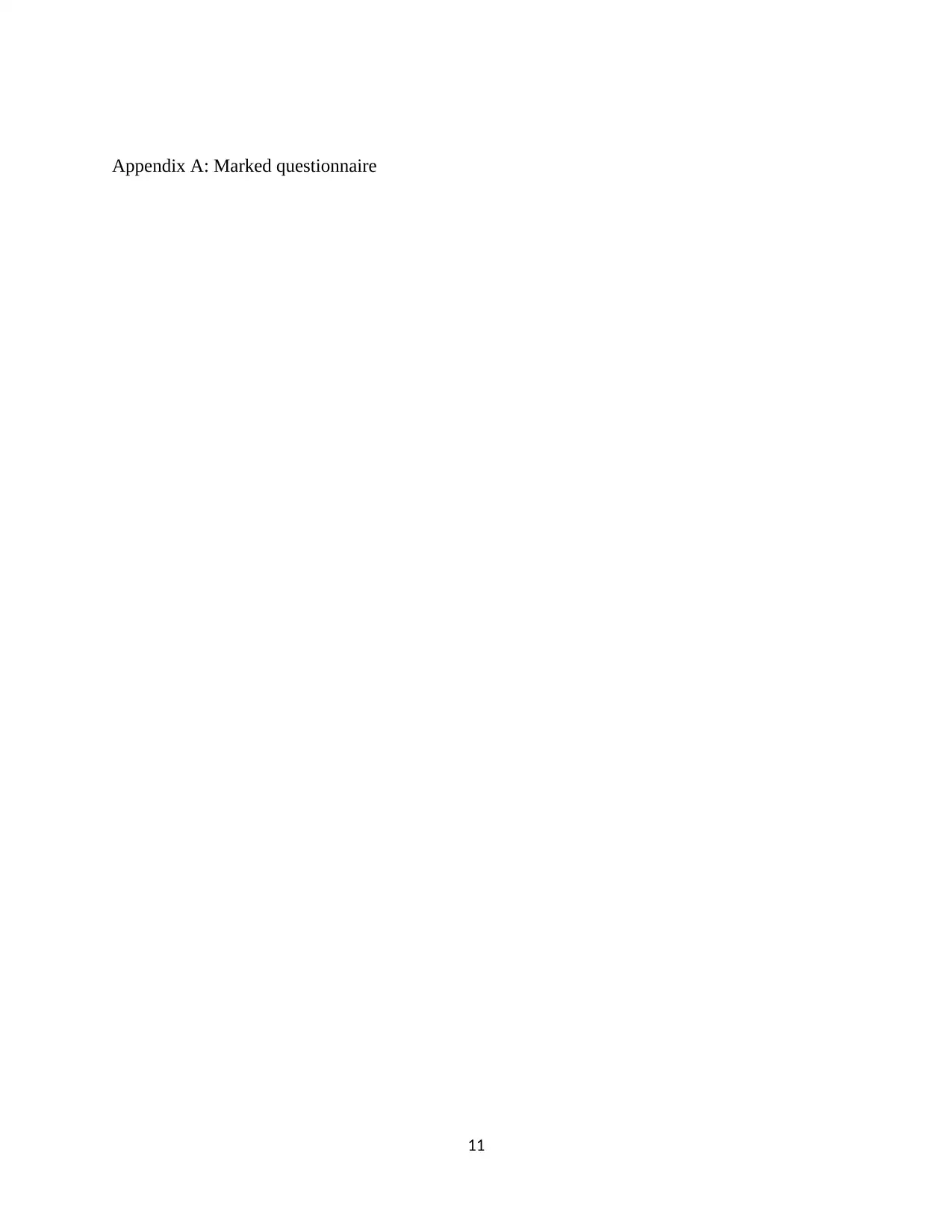
Appendix A: Marked questionnaire
11
11
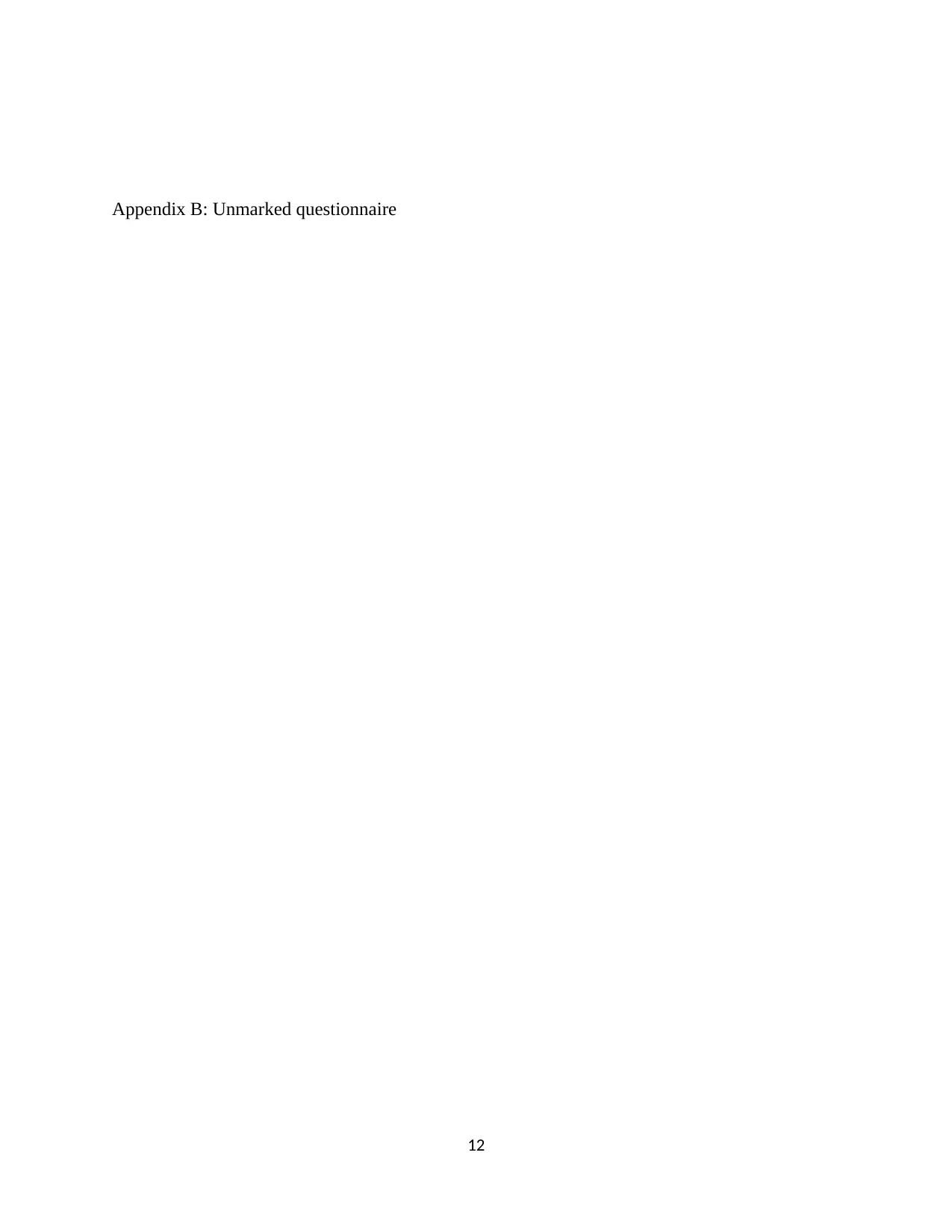
Appendix B: Unmarked questionnaire
12
12
⊘ This is a preview!⊘
Do you want full access?
Subscribe today to unlock all pages.

Trusted by 1+ million students worldwide
1 out of 12
Related Documents
Your All-in-One AI-Powered Toolkit for Academic Success.
+13062052269
info@desklib.com
Available 24*7 on WhatsApp / Email
![[object Object]](/_next/static/media/star-bottom.7253800d.svg)
Unlock your academic potential
Copyright © 2020–2025 A2Z Services. All Rights Reserved. Developed and managed by ZUCOL.



